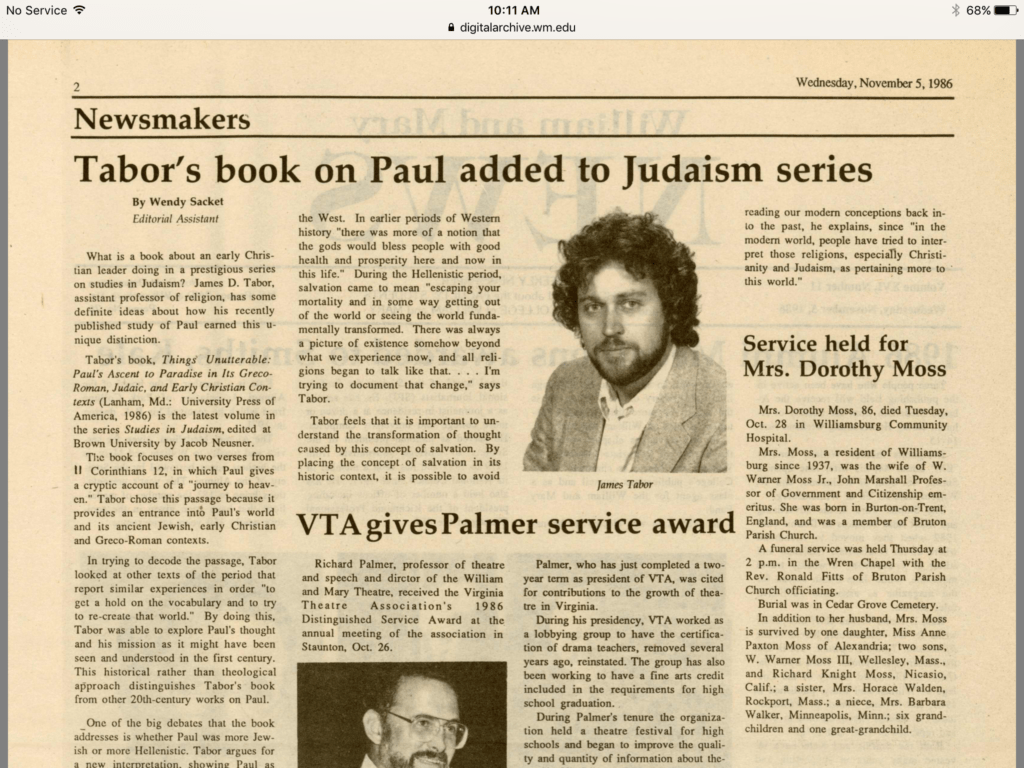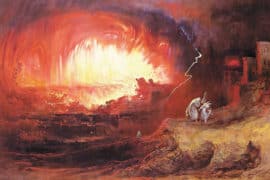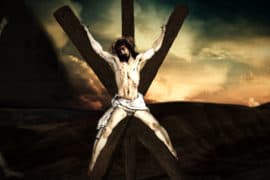Jacob Neusner, renewed scholar of the ancient Judaism, who so profoundly shaped the academic study of religions in terms of both method and content, died last October 8, 2016, on the Sabbath, at age 84. On the Jewish calendar that would be next Sabbath–called Shabbat Shuvah, which falls between Rosh Hashanah and Yom Kippur–when the gates of Heaven are still thought to be open. Accordingly we are coming up on his Yahrzeit (Tishrei 6) and I wanted to publish something in his memory today.
Neusner was as controversial as he was prolific, authoring over 1000 books and too many articles, op-eds, and letters to editors, to enumerate. There are numerous tributes to the extraordinary life and career of Professor Neusner, sometimes billed as “the most published man in history.” Most of them touch upon the complexity of both his personality and his contributions, see The Washington Post obituary, Tablet magazine’s review of the Aaron Hughes biography, Jacob Neusner: An American Jewish Iconoclast (2016), and Shaul Magid’s In Memorium in Tikkun Magazine.
For me “Jack” Neusner was a decades long friend and teacher (most memorable his NEH Seminar in 1985 at Brown University), and most important, he published my first book, Things Unutterable: Paul’s Ascent to Paradise in his Brown University Studies in Judaism Series in 1986 (not out of print). That book gave me the proverbial “leg up” following my Ph.D. to be able to hold positions at Notre Dame, William and Mary, and now for 28 years at the University of North Carolina at Charlotte. I owe a lot to Jacob Neusner and his scholarship has had a profound impact on my understanding of ancient Judaism(s). Our most common connection was that of Jonathan Z. Smith, who directed my dissertation at the University of Chicago, and despite tensions and misunderstandings, Neusner’s greatest intellectual influence when it came to the study of the religions of Late Antiquity. In later years he liked to remind me that “he gave me my first start,” with a smile, and an expectation of loyalty, that those of us who knew Neusner well understand.
I particularly value this interview with Neusner published in The Jerusalem Post in March 2010. I reproduce it here for my readers from my 2010 blog post as written:
 There was a fascinating and wonderfully wide-ranging interview with the esteemed Prof. Jacob Neusner in the Jerusalem Post last week. Neusner is known first and foremost for the ways in which he has brought a systematic critical historical study of the classic Rabbinic sources to the forefront of the academy, and for that matter, to the world. His provocative work, A Rabbi Talks with Jesus which came to the attention of Pope Benedict the XVI and has resulted in two meetings between Prof. Neusner and the Pope in which they have shared substantive exchanges. This interview takes a different direction. It touches on many important issues relevant to Neusner’s life-long academic work, but particularly his insights on Judaism itself in our time both in the Diaspora and in Israel. I produce it here in full, the link is: https://www.jpost.com/Home/Article.aspx?id=111090
There was a fascinating and wonderfully wide-ranging interview with the esteemed Prof. Jacob Neusner in the Jerusalem Post last week. Neusner is known first and foremost for the ways in which he has brought a systematic critical historical study of the classic Rabbinic sources to the forefront of the academy, and for that matter, to the world. His provocative work, A Rabbi Talks with Jesus which came to the attention of Pope Benedict the XVI and has resulted in two meetings between Prof. Neusner and the Pope in which they have shared substantive exchanges. This interview takes a different direction. It touches on many important issues relevant to Neusner’s life-long academic work, but particularly his insights on Judaism itself in our time both in the Diaspora and in Israel. I produce it here in full, the link is: https://www.jpost.com/Home/Article.aspx?id=111090
A Utopian Document, a Utopian Law
March 4, 2010
Jacob Neusner talks of his five-decade love affair with the ancient rabbis, on the future of Jewish life. Questions posed by the interviewer are in italics:
In the world of Jewish studies, Prof. Jacob Neusner needs no introduction. The 75-year-old scholar of Talmud and rabbinic literature has written, edited or translated more than 900 books (though he doesn’t want you to read them all), making him among the most active and prolific authors alive. “But I have a limited repertoire,” he says with a smile, an expertise which extends across a millennium and through dozens of difficult, tightly-written works that are the record of the rabbinic love affair with the Torah. For Neusner, the study of rabbinic literature has been a kind of love affair in itself, and as with all true loves, he remembers clearly when it began. He sat down to study his first passage of Talmud just after Succot in October of 1954, at the age of 22. It was the eighth chapter of Baba Kama, “Hahovel,” he recalls almost 54 years later. “I was an American history major,” and had always been a bit bored with the subject. “When I started studying Talmud, I finally came across something endlessly interesting. I had never met anything so challenging. It was like mathematics, only 1,000 times more complex. I was never bored again.” Now, struggling through the latest work, Sifrei Zuta Bamidbar, “a very strange text,” he is a happy man. “Every line is a challenge, the challenge of reconstructing the thought processes of the rabbis.” Educated at Harvard, Oxford and Columbia, with rabbinic ordination from the Jewish Theological Seminary, Neusner’s stature has made him a focal point of interfaith dialogue, such as a National Endowment for the Humanities-funded conference on tolerance among the world’s religions and a much-publicized theological exchange with the pope.
On a recent lecture visit to Israel, The Jerusalem Post sat down with the energetic professor, since 1994 at Bard College about two hours’ drive north of New York City, for a discussion on issues closer to home. Who were the rabbinic Sages? What can we know about their world? What can they tell us about Jewish life today?
Rabbinic writings are often in difficult, coded language, usually focused on legal argumentation. They don’t seem to reveal much about themselves personally, socially? We don’t have the basis for a biography on sound critical historical lines for any rabbi. The cultural patterns that shaped biographical writing didn’t exist. The rabbinic accounts of individuals are subordinated to systemic purposes they’re trying to serve. If you have a model of an individual rabbi, you have an expression of detail within a larger theory of the social order. We have in Halacha a design for a social order. It lays out rules of constitution, institutions and patterns of life of the ideal Israelite society. It’s a utopian document, a utopian law. Meanwhile, the aggada [rabbinic homilies] provides a system for a worldview which accommodates new knowledge and unexpected situations. The Sages show what it means to have a rational social order in which things fit together.
A rational social order-as opposed to our modern societies? Correct. The poetry of the 20th century discusses the collapse of the established order, the notion that the social order has disintegrated. The Sages dealt with a collapsing social order as well, represented in the destruction [of the Second Temple] in 70 [CE]. In the Mishna, 130 years later, we have a plan for reconstructing Israelite society that served us for 2,000 years.
How relevant is this plan for today? Can it help us construct a rational order out of the chaos of modernity? The question the Sages answered no longer imposes itself on the life of the community. The question was: “How does Israel exist as distinct from anything else?” The question of modern times is: “How does Israel exist together with everything else?” Here, Reform Judaism and modern Orthodox Judaism ask the same basic question about how to be both a citizen and a Jew. The Sages wanted to know how to be a Jew only, emphasizing the uniqueness of Israel.
This difference begs the question: Does the new question of modernity require a new Talmud, so to speak? Does the Jewish world need a new social order? For Jews in the Diaspora, the question of “Jewish and something else” is urgent. There are only two types of people who say you can’t be two things at once-those who believe in assimilation, a belief that is not institutionalized but is broadly held, and the self-segregating haredim.
What does the Talmud offer for integrated, modern Jews? There are two roles for the Talmud. First, it’s a model of how people can think, a demonstration of the value of rigorous, critical thought producing systematic results-that is to say Halacha. Second, it contains situation-specific lessons that can be generalized.
Does Halacha have a role in modern society, not just as an exercise in logic, but in terms of observance? As I grow older I return to my Reform roots from childhood. I find observance a matter of personal thinking. After Oxford, I was advised I’d get a better rabbinical education at [the Conservative] JTS than [the Reform] Hebrew Union College. At the time it had a superior faculty. So I ended up spending many years as an observant Conservative Jew.
If observance is personal, do you see the boundaries of Judaism as ideological or intellectual rather than halachic? The gap between self-segregating Orthodoxy and Reform Judaism is unbridgeable. They represent two very different notions of what it is to be an Israelite. But the boundary has to be both. People won’t be robots. They have to find rationale in what they do. That’s the strength of Reform Judaism, which is the strongest Judaism in the Diaspora.
There may be more Reform-registered Jews in the Diaspora, but they are personally less observant and intellectually uncommitted to Halacha. What do you make of the criticism that this makes for a weaker Judaism, not a stronger one? If people want to stop being Jewish, they don’t have to be Reform. Reform Judaism is a positive option. The Orthodox make up 10 percent of American Jewry, even if there is diversity there. Reform Jews are 50%.
Even so, are Reform congregants, the “Jews in the pews,” making deep choices in belonging to that movement? It’s easy to mistake people on the bus who are trying to reach a destination and people on the same bus going from nowhere to nowhere.
The Orthodox, it is often said, are growing faster than the other movements. The haredi [community] seems to be growing, but that doesn’t take into account the rate of attrition, the number of young people leaving that community.
What about patrilineal descent-the American Reform movement’s acceptance of Jewish identification through the father, and not just the mother as Jewish law and tradition have held? Doesn’t this create two Jewish peoples? There are more than just two Jewish peoples. In Israel, there is a whole variety. The split between haredi and the rest of Orthodoxy is as dramatic as the Orthodox-secular divide. In America you have a large population completely unaffected by synagogue life. Patrilineal descent is not as great a point of differentiation as Orthodoxy to everyone else.
What do you think the Sages would make of today’s Jewish world? That’s a good question. I don’t know. It’s hard not to project one’s own positions onto them, especially since rabbinic literature contains so many positions-kol davar vehipucho [everything and its opposite]. The classical position of the Sages is that you become an Israelite through Torah, through accepting its discipline. It would seem that Orthodoxy carries this forward. But the Sages expressed a liberal spirit in accepting people coming in, and this social policy would also have to be carried forward. Recognition of converts is a case in point. Ruth Raba contains the message that conversion is undertaken by the convert and the Jewish response is a welcoming one. Orthodoxy in Israel is the opposite of this.
The Orthodox position in Israel differs from that of the Talmud? It’s hard to know criteria by which the Sages would reject a convert. I can’t think of a single passage demanding [halachic observance].
This newspaper has commented on the seemingly growing cultural gap between American Jews and Israeli Jews, how little they seem to understand about each other despite their constant communication. Do you share that observation? I don’t know how I would measure [the cultural gap]. You have two different civil religions. It’s very difficult to teach these to each other. Civil religion requires a previous experience that is concretized and that can’t be taught. Young Americans don’t have the [Israeli] experience.
Is this the reason the liberal Jewish movements are not having as much traction in Israeli society as they have in America? I don’t know the Israeli situation well enough to comment on it. It would seem that Reform and Conservative are answering questions people aren’t asking. Israelis don’t regard Judaism as an ongoing adventure that responds to new questions with authentic classical answers. The strength of Reform Judaism is that it responded to masses of Jews who wanted to be different than their parents. Even in America, Israelis form a community unto themselves, building their identity on the Hebrew language and Israeli customs.
Are you a pessimist, then, on the future of Israel-Diaspora relations? The experience of visiting Israel has a good impact. But if success is measured in aliya, this hasn’t been successful. [American Jews] are Americans. America is not an exporter of immigrants. We’re the only Western society not losing population. On the other hand, I’m not a great witness to the wisdom of an intellectual on issues of Jewish public life. When Birthright announced it was going to spend millions bringing young Jews to Israel, I thought this amounted to an evasion from day school education. But I was impressed when I saw my students coming back.
How do you see the cottage industry of conferences and committees looking into strategies for the future of the Jewish people? The most important thing happening this week or any week in the Jewish world is what’s taking place in the classrooms of the universities. The future of the Jewish people is in the hands of Jewish intellectuals. Politicians and public intellectuals nourish themselves from scholars who are not at those meetings and have no interest in them. It’s hard to engage too seriously in social science as a medium of cultural mediation. They’re measuring the present and not facing the future. For example, when I started my career there was no such thing as Jewish studies in universities, just a few professors of the Hebrew language. Now there’s a Jewish studies professor in every university in the US and Canada, and that cultural resource is beginning to hit the Jewish community. Young people are coming with an intellectual background that’s the result of my generation’s commitment to an ambience of Jewish learning. It didn’t come because people held conferences and passed resolutions. It came about because universities decided to turn to culture.
You are an outspoken critic of the study of rabbinic literature in Israeli academia. What, in summary, is your criticism? The stress is on problems of philology instead of problems of culture. But philology is of interest only to specialists, while the Sages represent a resource of thought and expression that provides a model of the social order and how society can deal with conflict and instability. In American academia, the Sages are treated as accessible models for shaping everyday life. We study the classics of any civilization to find viable examples of what we can be ourselves, of our own potential. The age that confronted the Holocaust should understand the Sages’ discussion of the destruction of the Temple, of rebuilding a social order.










Comments are closed.